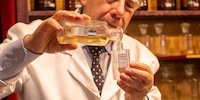
Background information
«Sava» Perfumery in Belgrade – «Everyone deserves to smell nice»
by Carolin Teufelberger

The handmade sweets from «Bombondžija» are well received by locals and tourists alike. So much so, in fact, that the shop is being expanded. But one thing has stayed the same: the recipes – since 1936.
During my visit to our Belgrade office, the house on Gavrila Principa Street immediately stuck out to me. Its sloping roof stands out from the old perimeter block development project and showcases the exposed concrete of the Brutalist buildings on the horizon. Inside, it proves even more interesting. This is where ratluk is still made by hand.
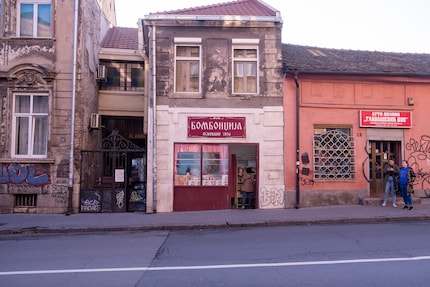
«Ratluk is a kind of Turkish Delight, only better,» Milica Bosiljčić explains with a grin, wearing an all-white outfit topped off with a hairnet. To underscore her statement, the 22-year-old great-granddaughter of the founder of«Bombondžija» immediately hands me a vanilla-flavoured morsel. It’s less sweet, but creamier than I’d expected, this Serbian confection. I’m told that winter is an especially busy time. That’s in part down to Christmas and New Year, but also because of «Slava» (link in German), the Serbian-Orthodox tradition of celebrating your family’s patron saint. Milica explains it’s customary to bring ratluk to the celebration.
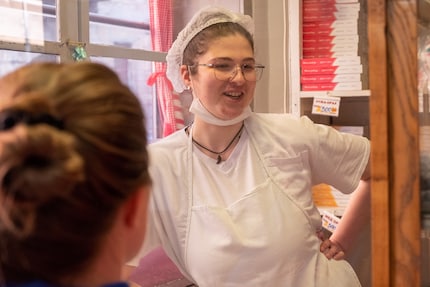
Business is so good that the family plans to expand next year. The store and production areas will each get their own space, Milica explains. Currently, the two areas are separated only by a red and white chequered curtain. In front of it is colourful, boxed candy in over a dozen flavours including plum, rose and peanut.
Behind it are old, silver machines. The Bosiljčić family designed most of their equipment themselves; it was already difficult to get the right tools back in the day. The die-cutting machine is still operated by hand – just as it was at the time of the shop’s opening in 1936.
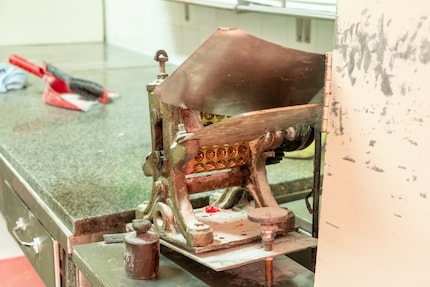
Milica’s great-grandfather, Branko, was from Valjevo in western Serbia. He learned the sugar confectionery trade in various businesses in Belgrade before opening his own shop. That one was located at a different address and offered only one flavour: bergamot. The caramel ratluk recipe was developed during Branko’s time at university, as part of his thesis. However, the most popular varieties to this day remain rose and vanilla – which older people refer to simply as red and white ratluk.
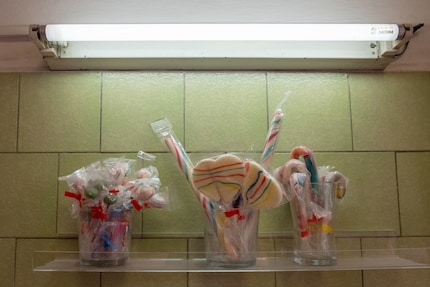
Just like the machines, the recipes remain unchanged. «We still use my great-grandfather’s recipes,» Milica says. She’s been involved in the business from a young age. «My dad says this is where I learned to count.» Currently, Milica is not only working in sales, but also learning all there is to be done in the background, namely accounting, human resources and marketing tasks. Most likely, her father will pass down the business to her – the fourth generation. «My younger sister is studying graphic design, the other philology. I don’t think they’re all that interested in the shop,» Milica says with a laugh.
Milica still has to learn the craft itself before she takes over the business. So far, she only knows it in theory – that it takes six hours to mix 100 kilogrammes of ratluk mass. After that, it’s left to cool overnight on a metal tray so that it can be shaped the next morning.
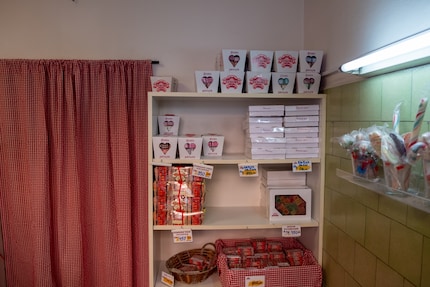
These candy cubes are a staple not only among trueborn Belgradians, but are also gaining in popularity among tourists. Quality speaks volumes. «Many people buy our ratluk as a little something to take back home. In exchange, they’ll sometimes bring us souvenirs from their country.»
I take this as my sign to snag a few small boxes for our office in Zurich. I’ve certainly filled my backpack with much sillier souvenirs than this.
My life in a nutshell? On a quest to broaden my horizon. I love discovering and learning new skills and I see a chance to experience something new in everything – be it travelling, reading, cooking, movies or DIY.
Interesting facts about products, behind-the-scenes looks at manufacturers and deep-dives on interesting people.
Show all
Background information
by Carolin Teufelberger
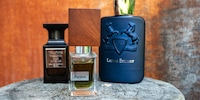
Background information
by Patrick Bardelli

Background information
by Ann-Kathrin Schäfer